
Tim B
-
Posts
2,234 -
Joined
-
Last visited
-
Days Won
2
Content Type
Profiles
Forums
Blogs
Gallery
Events
Store
Posts posted by Tim B
-
-
Hi Phil,
Well, there are only three people actually discussing this issue presently, so I would hate to say anything for sure at this point. There are many shield collectors out there and who knows...there may be more to see yet.
Right now, I would tend to support the idea that the Deumer shields with the "round" head or those shown in posts 1-9 are in fact from the same die. The minor differences I believe are attributed to wear and you can kind of see a progresson within that style. Where the attachment pins come in exactly is yet to be determined and the issue of zinc vs steel is also something that still confuses me on these.
As I do not have Weber's more recent book, I can't comment on the third shield he attributes to Deumer. What does that one look like?
As far as the second type Peter and I are now thinking might be from a second die (the flat-head), I would like to see more before committing to stone. What I would like to see is a good high-resolution PIC of the front and see if that die flaw is there as well.
What do you think about all this? Don't be shy here to express your views. Your opinions count as much as ours.

Tim
0 -
Hi Frank!
From Hendrik's site: At first this palm bore the royal monogramme consisting of 2 letters "L", the last one mirrored on the first one, with "III" in between them (Leopold III). On 26 November 1952 this was changed into a single letter "L".
So, perhaps the palm was awarded or added later.
Tim :cheers:
0 -
I just checked Weitze's site and see he has one with the round wire pins for sale. From what I can see in the PICs, the pins appear original to the shield. The wear on the head is close to that shown by Weber, maybe a bit more worn but, close. This one is without back cloth.
Tim
0 -
HI Tim....yes, that's how I see it...in fact I don't see the type 2 in either of Sacha's krim books
 ....so, how about this summary
....so, how about this summaryType 1 (posts 1-9) Zinc Bronzed/Plain
Sheet Metal (Magnetic) Bronzed
Type 2 (posts 10-14) Zinc Bronzed/Plain
Hi Pete,
Yes, I could agree with that statement. Odd, if the die was changed, that the majority of details remained almost spot-on identical except the head. But, if we reversed the two, with the 10-14 type being first, then we shouldn't be seeing those only in zinc and the 1-9 types in both metals. So, the die must have changed as you could not repair or rework the original die to add more details and actual material to the base, (i/e: the head area, making it more pronounced) IMO.
Tim
0 -
Again the type shown in posts 10 & 14 (i assume both Zinc) are IMO identical both bronzed/Plain
Peter,
I can only assume your correct as they look zinc in the PICs and the corrosion leads me to think along those lines. I also just noted that the shield in post 10 is in fact the same as that in post 11.
 Not sure where (who) I got that PIC (#10) from but, they must have bought it from Weitze.
Not sure where (who) I got that PIC (#10) from but, they must have bought it from Weitze.Tim
0 -
Hi Peter!
Yes, I was wondering if the round pins might be later as well. The PIC he shows (in my reference) has cloth over the pins, so I cannot see if the pins are original to the shield or if maybe they are replacement pins. Do yo know of other examples of this type? Seems like Pascal once stated he had one or seen another one as well, but don't quote me on that anymore as I may be mistaken. Been so long ago.
So, if I read your comments correctly, do you also think the two versions of Deumer shields are those like the ones shown in posts 1-9 and the 2nd version in posts 10-14?
Cheers my friend!

Tim
0 -
I've had a little more time to sit down and study Weber's reference shields again and I must say that I find very little difference between the shields shown on pages 26 & 28 other than the attachment pins. There might be some minor wear difference in the head area, but it's minor and could be attributed to worn/dirty dies or maybe even a shift in striking during the manufacturing process. The other details are the same in my opinion.
With that; I think I need to change my write-up earlier and say now that all the shields posted in posts 1-8 are the same. In post #9, I think this is just another case of more wear on the die in the head area and Weber does not show one with this level of wear as previously thought. Again, I think it is the same shield as the two shown on pages 26/28, just not to the same wear level.
That still leaves the flat-head and any timelines that can be deduced.
Tim
0 -
Hi Phil,
Well, now you are starting to see some of the dilema and thought provoking questions I have had on these Deumer shields. Unfortunately, there isn't always a "discussion" over at WAF, so let's look at bit more here.
Again, I'm using Weber's earlier reference here. The shield he shows on page 26 is supposedly in sheet zinc for both the shield and back plate. This one he shows has the round wire style pins. Not sure if this exact shield is shown in the reference you have (?) but, assume it has to be.
First, we make the assumption that these wire-pin styles were manufactured initially prior to switching to the flat style pins. If that were true and I'm not saying it isn't, why would the early style shield be manufactured in zinc and not sheet steel (magnetic) like those shown to have the same die characteristics as the example in post #6? Weber does state that this style (with the wire pins) is known to exist in steel as well, but as far as I know, I haven't seen any; but why make it in zinc at all early on?
Second, we normally timeline the use of better quality materials (buntmetal, tombak, etc.) early on and progressing to zinc as vital war materials became more scarce. That mandatory crossover was supposedly circa 1943, though no definitive timeframe was ever set in stone. So, with the Krim award being instituted in July 1942 and the final date for awards set in April 1943, then is it possible that both materials were used early on and "perhaps" the ones we see in sheet steel are just existing stock or a decision made by the manufacturer that the strike was as good in zinc, so...?
Now, for an interesting turn; Here is a composite closeup of the shields in posts # 10 & 14 that have the flatter heads. I cannot get clear closeups and these are the best I can do with what I got, but there is "something" there in the same general area that Peter shows on his compostite comparsion above. Not saying its the same, but something is there.
Also, keep in mind that all the other details are still the same between these varieties. So...?
Hey, at least we are trying to figure this one out!


Tim
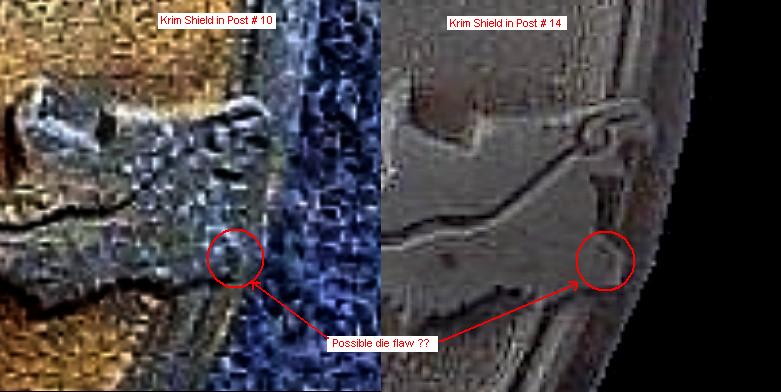 0
0 -
Hi guys!
Phil, no worries, the whole purpose of having discussions is to see what others think and to learn from other's observations. I do not have any Deumer shields in my possession and cannot make accurate statements one way or the other based just on photographs and other people's descriptions. Now, if the concensus shows that something is what it is...well then you take it as accurate information. Glad you're here!
Any chance you might be able to take a shot of the shields side by side showing the difference in size on the two you are talking about or maybe a cut & paste composite that is in correct size on both shields?
Peter!!
That's great, I have not had time to really sit down and look at the large format PICS you sent me, but I see it. Is there any other spots/indicators?
Tim :cheers:
0 -
Interesting marks Rob. I'll add one as well, this also square on a miniature Verdun commemorative (Vernier).
The regular Vernier style commemoratives are marked by Monnaise de Paris with the cornucopia and "bronze" on the edge, but this piece is smaller and in silver gilt with the mark on the face. Only one I've seen.
Tim
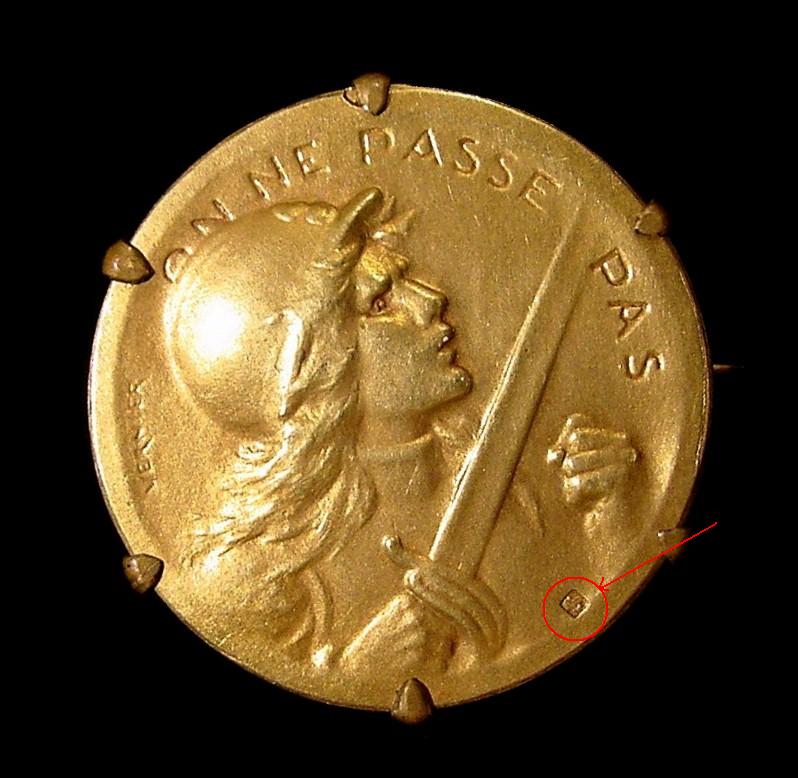 0
0 -
Hi Phil,
A couple quick notes and then I gotta run but, I'm sure Peter will be chiming in soon. Hopefully other shield collectors will kick in as well (?)

First, the thing about taking measurements (size and weight); is everyone has to have the same criteria when doing this. This means they have to have a reliable and calibrated measuring scale, know how to use it and take a couple measurements to get the "average" so the one time it weighs a couple of grams different, you can rule that one out. Of course, as you already alluded to, there are a lot of variables such as material used for the shield, backplate, if it has cloth/paper, missing pins, etc. I really don't put much confindence in weight alone, just use it to see if its in the ballpark. There are cheap reliable scales on the market. I suggest getting one that has the ability to measure in grams.
Size dimensions should be very close though but, again, it requires the people doing the actual measuring to be consistent with their measuring instruments and consistent with exactly where you take the measurements. A slightly different placement on the shield could yield a minor difference in measurement, but if we're talking 2-3 MM, it could happen, especially if there is wear and ... someone doesn't use the dial caliper correctly. I have measured badges before and often take 2-3 measurements just to ensure I didn't overtighten the knob, or let something shift.
And, everyone has to do it the same! I assume the measurements you're referencing are taken out of Weber's book, but did he do all the measurements himself, or get the information from other sources?
So, bottom line and in my opinion only, use the die characteristics most of all and the "measurements" to weed out the out-right fakes.
As far as the Deumer connection to these shields; you're correct that we haven't seen any actually marked with a manufacturer's logo, but, and Peter can confirm this, several of these "types" have been seen or taken off of Dealer "sales boards" and it was just considered a given that they were from Deumer as other products on the board were marked with Deumer markings. Same can be said of the Deumer style Narviks.
Hope that helps answer some questions.

Tim
0 -
Peter sent me these two PICs today and you can see the one on the left (same shield shown earlier in post #6) is identical to the zinc version on the right.
So, perhaps this is more actual evidence of multiple type differences.
Pete, can you confirm the shield on the left is stamped bronze sheet or zinc? Thanks for the PICs buddy!

Tim
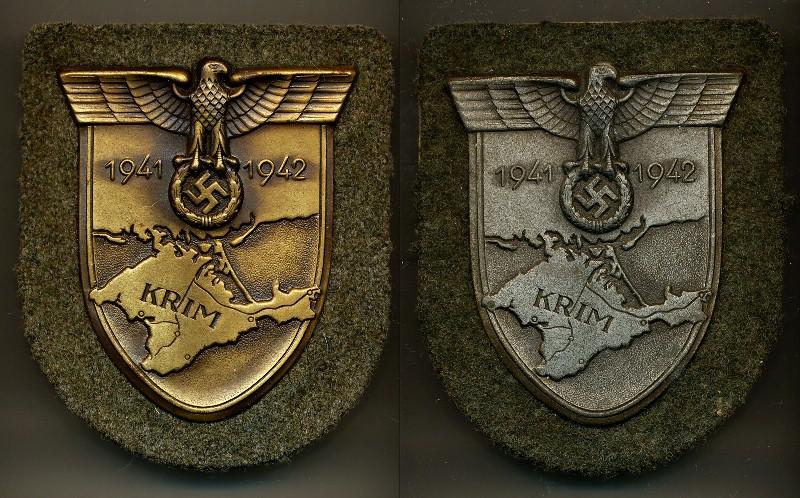 0
0 -
Hi Phil,
Yes, having different references will be one of the issues when discussing these shields, but I think we can still get some good information out of it. Weber only lists two shields as Deumer in the first book and I show examples of those. I expect he used the same two and added a third to his second revision.
Interesting shield you have there and I can't make out the head in great detail, but it appears different from the three I showed above. Can you confirm? Again, all the other details are correct and consistent.
Also interesting is the size difference you mention

So, good start my friend!
Tim
0 -
Hi guys!
Thanks for the compliments Phil, no worries, you'll catch up fast enough I'm sure.
Peter, that's a great looking Demjansk. I see another one for sale with the paper backing still on but, they aren't giving it away for sure.
 I still need and want one of these but not at that price.
I still need and want one of these but not at that price.Just got confirmation that this one is coming my way. I will probably start another "detail in-depth" thread on these and the "supposed" connection to Orth shields and see what develops. I don't really see it and hopefully some light will come out of that thread.
Cheers you two!

Tim
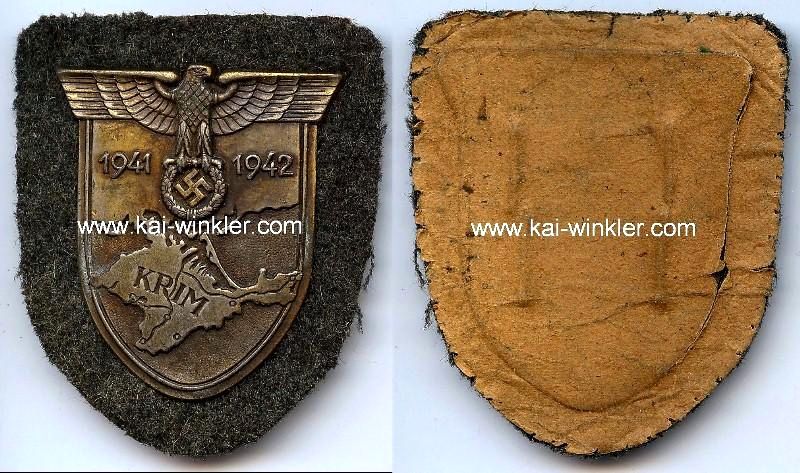 0
0 -
Playing and just an update to the collection group shot!

Tim
 0
0 -
And, a better close-up of the head. You can see the actual head line on this one.

So, now what to think? If this style is in zinc, what about the other styles and which came first?
Tim
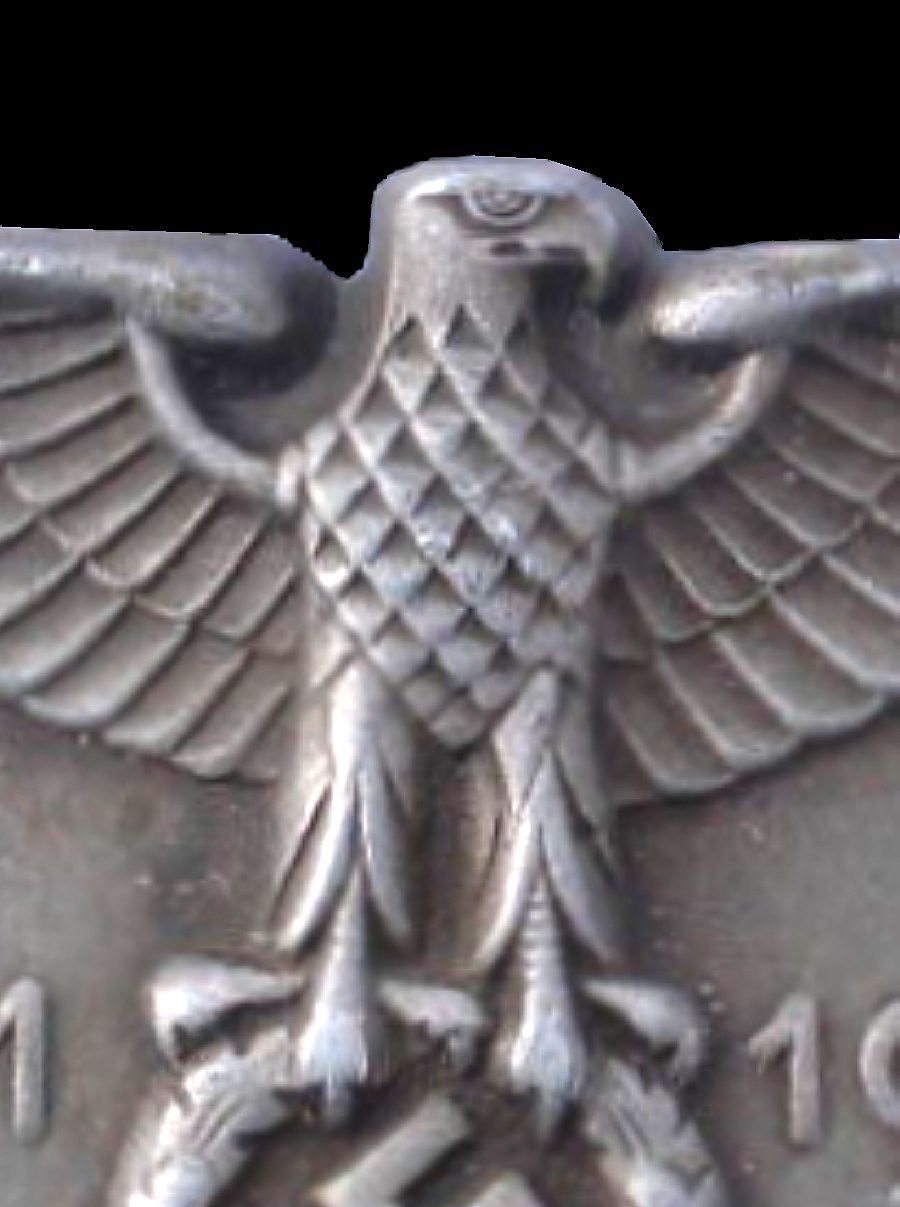 0
0 -
Ah, another late addition and in zinc. Note the head.
Tim
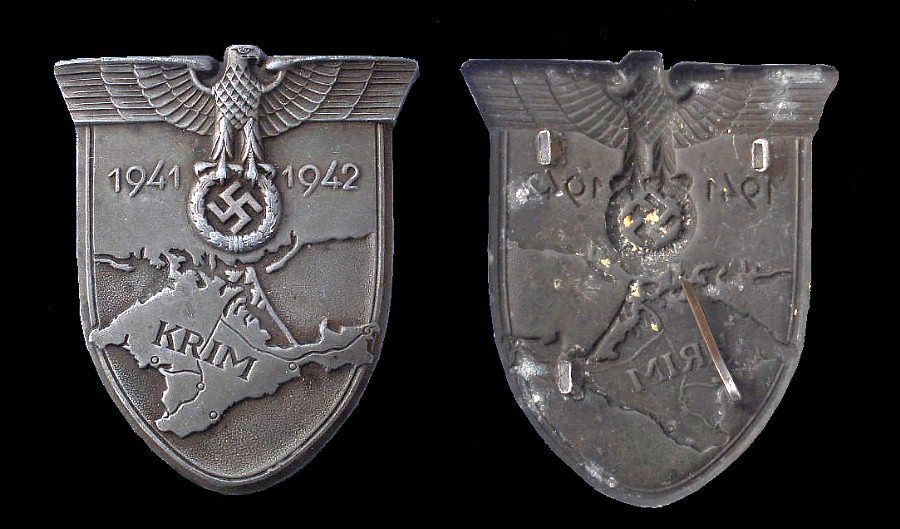 0
0 -
Okay, now for the questions and hopefully some discussion.
Some questions I have:
1) On the example shown on Page 26 in Weber's book with the round wire pins; where would that fall into as far as production time. My understanding is that the round wire examples were thought to be the earlest versions? If that were true, then it would not support the timeline I think and discuss above as those shields with the flatter head and more distinct features all have the flat style pins.
2) Weber alludes to the shields in his book as two different style Krim shields; (pg 26 & pg 28). But, if the shields are two completely different shields, how would the details (other than the eagle's head) be exactly the same? IMO, the die is the same, just a wear difference.
3) What style, if any, were made only in zinc?
4) How many shields with the round pins do we actually know about and are they all the same version as shown in Weber's page 26 example?
I'm ready to hear other opinions.

Tim
0 -
Last, here is a comparison of the three different style heads and...if you might follow me for a moment...what may be a timeline of die progressions of the Deumer shield. Again, dies don't get better with age and the details generally get poorer as time and use wears on them. Keep in mind that on all the shown examples above, the other details have remained consistent throughout.
Tim
 0
0 -
And, another example.
Tim
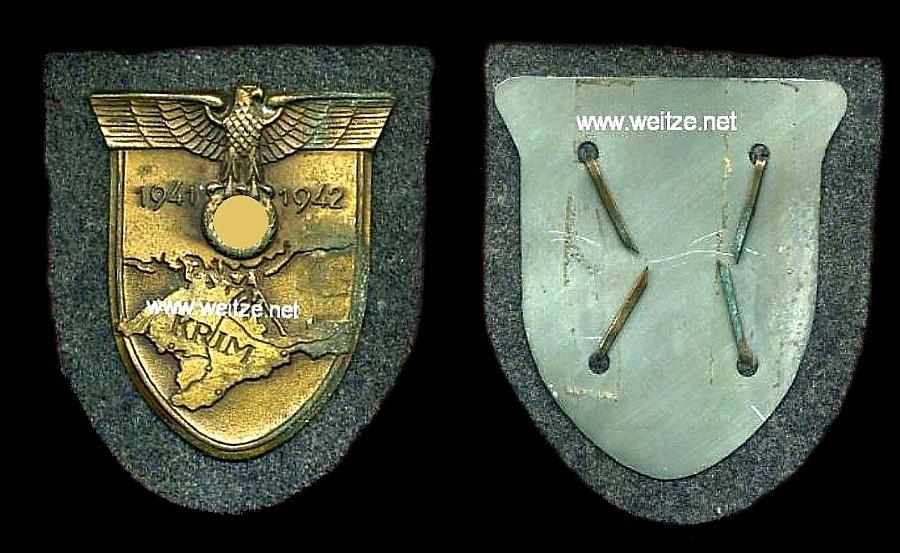 0
0 -
Then, there is this type. Now, I have seen more than a few with these details so I know it's not just lighting or a case of one or two that exist, but note the head details are very crisp and striking. The beak is well defined and the top of the head is flat. The definition between the eyes, mouth, and beak is very clear on this style.
Note again, all other details remain the same
Tim
 0
0 -
Now, in this PIC, we see something slightly different. Note the eagle's head and how it appears less detailed or worn across the top. If you compare the top edges with the previous examples, you'll note this one has more slope to it. This is not the only example and is also shown in Weber's book on page 28. I might think this happened when the die got worn and maybe cleaned or widened a bit.
Note, all the other details have remained the same though!
Tim
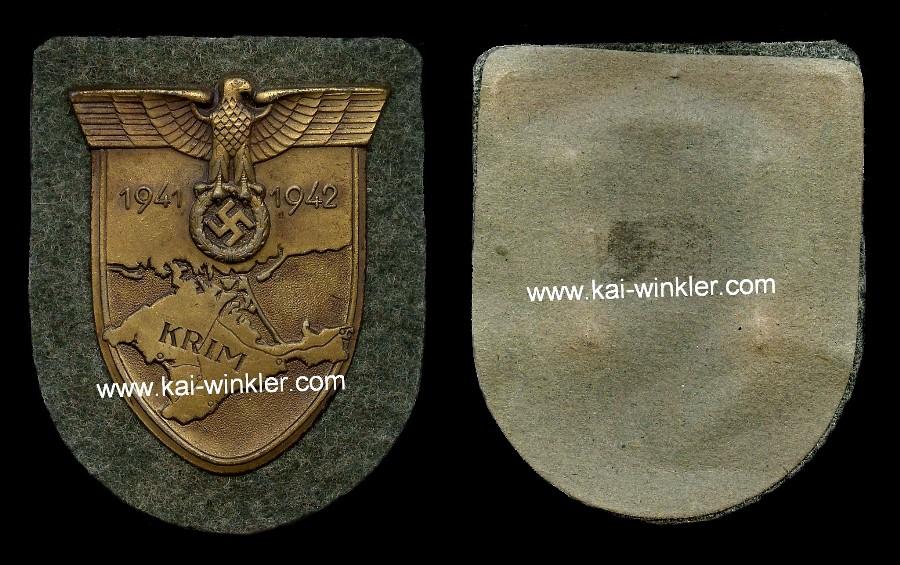 0
0 -
And yet another, in near mint condition despite the corrosion on the eagle's head and right side unfortunately. No backing on this one but, the details are still identical to the previous ones.
Tim
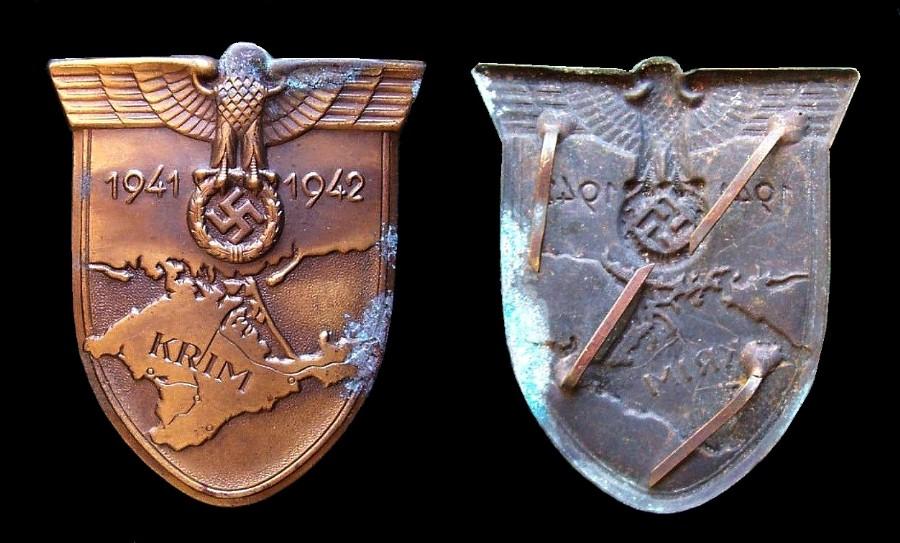 0
0 -
Another, same type example with more rough finish.
Tim
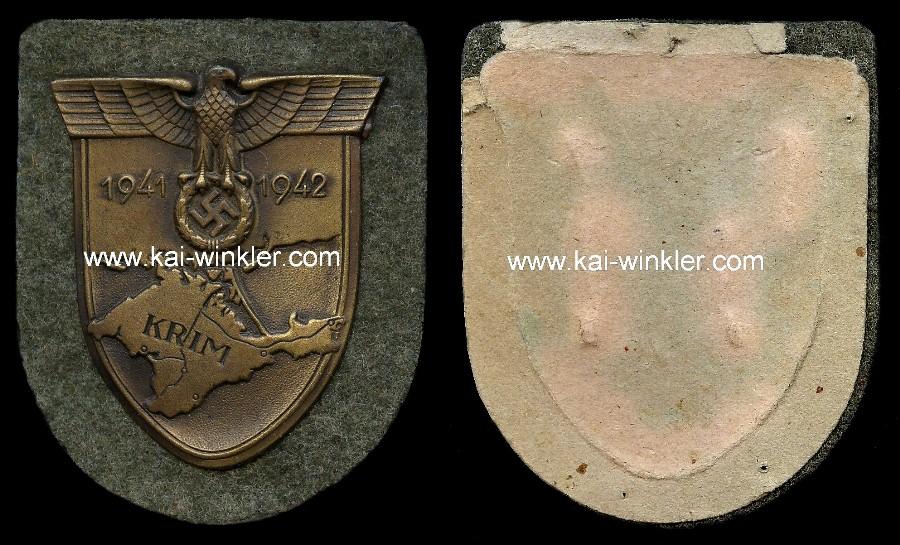 0
0


Deumer Krim Shields
in Germany: Third Reich: State, Civil, NSDAP Awards & Decorations
Posted
Phil,
That's a nice PIC of the Flat-head; do you own that one? Any chance of getting a little clearer shot of the area in question?
So, do you think that this style is now a Deumer?
Tim